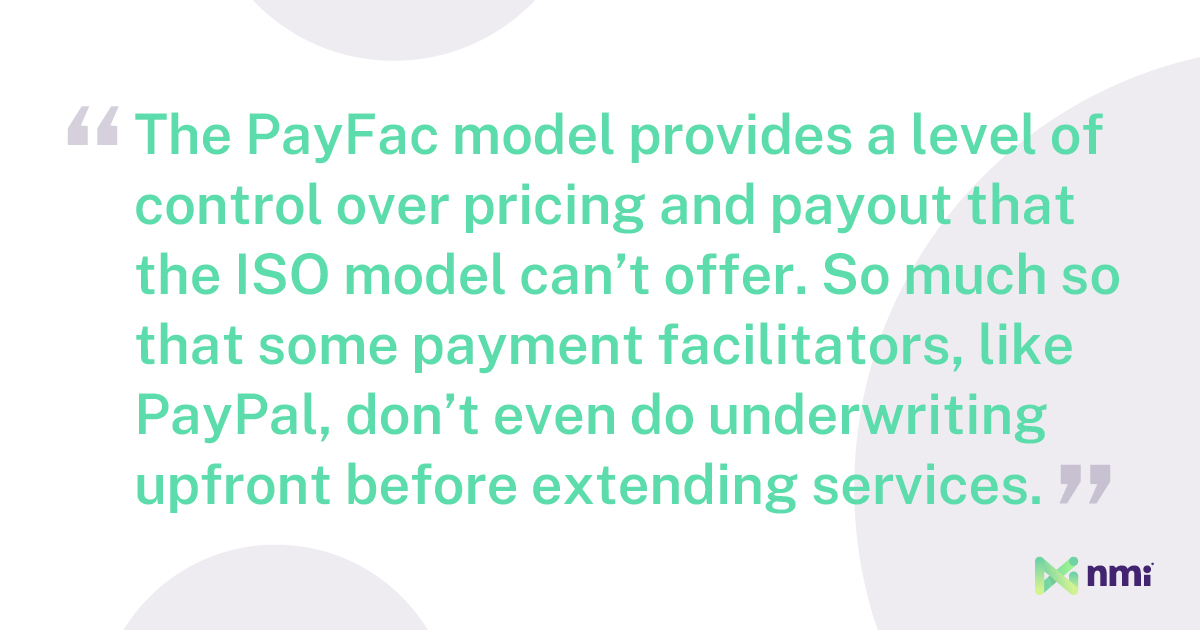Payment facilitators (PayFacs) are companies that provide merchant services to businesses in various industries. Their primary service is payment processing – the ability to accept electronic payments via debit and credit card. But, many PayFacs also offer value-added services like fraud protection, secure data storage, advanced security (like tokenization) and more.
PayFacs aren’t technically direct acquirers. Like independent sales organizations (ISOs), PayFacs are intermediaries that resell payment services supplied by partners like payment processors, acquiring banks and even third-party software vendors.
They make it faster and easier for merchants to access the payment solutions they need while helping their acquiring-side partners tap into a larger base of customers. In exchange, PayFacs charge a markup on all transactions their merchants process – commissions known in the industry as “residuals.”
But where do PayFacs differ from traditional payment providers? And what are the benefits of becoming a PayFac versus an ISO?
How Payment Facilitators Differ from ISOs
PayFacs and ISOs fill very similar roles in the payments ecosystem. However, a few significant differences in how PayFacs operate set them apart from their ISO cousins. These differences impact everything, from how they interact with merchants to how much they earn and the level of risk they accept.
PayFacs Own Their Merchant Relationships
One of the biggest distinctions between PayFacs and ISOs is how each interacts with merchants. ISOs are intermediaries; they pass on merchants to their processing partners. While certain ISOs can be a party to a contract with a merchant, they can’t be the primary party – a payment processor or acquiring bank must fill that role. The ISO is either a third party or, in most cases, not contractually involved with the merchant.
PayFacs, on the other hand, have direct contractual relationships with their merchants. In the PayFac model, the PayFac itself is the primary merchant. It partners with an acquiring bank and receives a unique merchant identification number (MID). The merchants it recruits become “sub-merchants,” processing their transactions through the PayFac’s master merchant account. Money from sales goes directly into the PayFacs’s master account and is then distributed to the sub-merchants either periodically or when they initiate withdrawals.
PayFacs Take On Underwriting Responsibility
Because payment facilitators “own” their merchants, they also own all the risks associated with each one. If a merchant commits fraud, disappears or generates too many disputes, the PayFac is on the hook. As a result, PayFacs are responsible for underwriting – the due diligence required to ensure a new merchant represents an acceptable level of risk and is worth doing business with.
Most ISOs don’t do underwriting. Sometimes, certain ISOs (wholesale ISOs) will participate in risk assessments and share liability with their processor or acquiring bank. However, most standard ISOs – known as retail ISOs – take on no underwriting responsibility and no risk whatsoever. They are purely there to serve sales and support functions.
Underwriting responsibility is a big deal because due diligence has the potential to be both time-consuming and expensive. Getting it wrong could expose a PayFac to significant risk. On the other hand, taking the time to get it right can cause bottlenecks when not streamlined – a delicate balance.
PayFacs Often Enable Software Integrations
There is an emerging sector known as embedded payments, where software developers and independent software vendors (ISVs) incorporate payment acceptance on their platforms.
Most ISVs sell software geared towards businesses that need to take payments, such as barber shops, veterinarians and contractors. Traditionally, those business users would find payment processing options from a third-party partner. However, many software providers have realized they can offer payment processing on their own platforms to streamline the customer experience and monetize transactions.
Becoming a PayFac is an elegant way for these software providers to build payment processing into their software. With embedded payments, they can offer vertical integration, improve the user experience and bolster revenue.
eBay was one of the first examples of a business adopting vertical integration through the PayFac model. When eBay first hit the scene, it offered users auction services but left arranging and securing payment to the seller. Before long, eBay’s team realized users would benefit from taking payments directly through the system. Eventually, this led to eBay acquiring its own PayFac – PayPal. Although considered a revolutionary move then, this blending of tech and payments has become commonplace.
The Key Benefits of the Payment Facilitator Model
Nothing stops an ISV from becoming an ISO and offering payment processing to its clients through that model. So, why would a software vendor (or any payments company) choose to be a payment facilitator over an independent sales organization? The short answer is – PayFacs have more control.
Total Control Over Merchant Acceptance
Retail ISOs enjoy little-to-no risk from the merchants they recruit. Unfortunately, their processing partners have the final say on which merchants to accept (or reject). This means ISOs could lose hours of prospecting and sales efforts and miss out on an entire category of lucrative (albeit potentially risky) customers.
For businesses looking to offer payment services, that lack of control over merchant acceptance can be a deal breaker for two reasons:
- Businesses like software providers may want to onboard most of their client base or users to payment services, rejecting only the riskiest among them
- Merchants signing up for payments through a software provider or similar business expect the process to be swift; a slow underwriting process performed by a traditional processor won’t cut it
The PayFac model eliminates both problems. By offering control over merchant acceptance, this model enables businesses to extend services to a wider pool of customers than they could as a retail ISO. It also makes it possible to shorten time-to-processing significantly, improving customer satisfaction and retention.
More Control Over Pricing, Payouts and Risk Acceptance
Naturally, PayFacs must factor any additional risk into their pricing. Because fewer merchants are filtered out, more problems will eventually arise. Revenues must be high enough to offset any costs associated with the occasional bad actor that slips through the cracks.
The PayFac model offers control over pricing and payouts that the ISO model can’t. Some payment facilitators, like PayPal, don’t even do underwriting upfront before extending services. Nearly every applicant that applies is accepted, with risk assessments happening after the fact.
Although postponing underwriting is a risky practice for all but the largest payments companies, it highlights the fact that the PayFac model enables flexibility and creativity when managing associated costs and risks.

Becoming a PayFac With NMI
NMI’s gateway, merchant relationship management and embedded payments solutions provide PayFacs, ISOs and software developers with everything they need to offer elevated merchant services. We combine flexible payment processing, an industry-leading gateway and a vast range of value-added services to provide the simplest, most frictionless way to get merchants selling faster.
For payment facilitators, NMI offers a turnkey platform that includes:
- Frictionless, instant onboarding
- Built-in KYC verification
- Unique sub-merchant billing and accounting
- Complete sub-merchant reporting
- Automatic dispute notification
- Automated underwriting and monitoring
- Merchant management and recruiting
To find out how partnering with NMI can streamline your company’s merchant recruiting and payments delivery, or make your transition from software provider or ISO to PayFac as frictionless as possible, reach out to a member of our team today.




